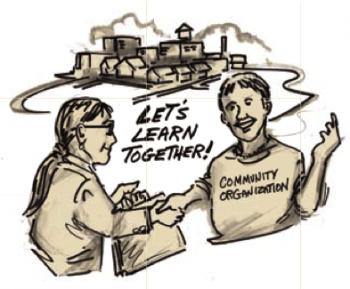Serendip is an independent site partnering with faculty at multiple colleges and universities around the world. Happy exploring!
Sarah's blog
Memo 3
My memo addressed one of my struggles throughout the semester in the Cannery, which was the power dynamic between the Bryn Mawr and the Cannery women. I imagined what to would look like to revise our class through the PAR approach and discussed obstacles that would make this difficult, and successes in the class that put us on the right track to PAR.

Linda-Susan Beard's visit
Last week I felt anxious knowing that Linda-Susan Beard was coming to class. As an atheist I must admit I often make assumptions about people who hold religious positions, particularly that they are going to shove religion down my throat, or that they will automatically hold distain for me as an atheist. I arrived to class a little late and frazzled, which added to my anxiety. Right when Linda-Susan began speaking though, I felt very soothed by her voice alone. I really loved her introduction of humming followed by silence, as it allowed me to collect myself. When she was telling her story of being angry at God for allowing her nephew to be murdered, my eyes began to water, as this is a story I felt I related to when I was younger and questioned the existance of God in response to the death of my mother. I really wanted to ask Linda-Susan if there were something specific about the silence that allowed her to forgive/reconcile her relationship with God. I also wanted to ask her what she thought the connection was between religion in morality, because the struggle I face the most as an atheist is people thinking I am therefore not a moral person. I didn't ask this though, because I felt anyway I would phrase it was going to sound like an attack on her religion, which I feel she might hear a lot on a Bryn Mawr's campus. Even though I didn't ask my questions, I am still glad she came to class, as it reminded me once again that I hold assumptions that need to be challenged.
separating church and school
The thing that struck me most about the last reading was the writer's devotion to God and how she understood this devotion to be essential to learning. I'm so used to "separation of church and state" that being asked to "pray" as part of our class on Thursday caught me off guard. As someone who is not religious, I wasn't really sure how to pray or what to expect in response if I don't believe there is a God. At one point she discusses how difficult it is to learn from text alone rather than a teacher and says "yet I suffered these trial most gladly for the love of learning. Oh, if only this had been done for the love of God, as was rightful, think what I should have merited!" (53). I think this is so interesting because the general message I receive on Bryn Mawr campus is that learning for the sake of learning is one of the best/most admirable attitudes to have, but the writer of this piece is left feeling guilty for her personal love of learning because she feels as though she is being selfish and giving proper respect to God. The writer's tone of humility or even unworthiness also struck me; she states "all that I have said can do no more than other that letter to you in recompense for the failure to apply myself which you must have inferred (and reasonably so) from my other writings." (45) I wonder if this tone has to do with her religious beliefs, or her gender. From what I gathered, she seemed highly educated and this was written at a time when women didn't have much access to education.
Jody's assignment
Sasha, Jomi, and I made a prezi about a timeline of the history of African American students at Bryn Mawr. We also have a physical timeline that we will bring to class Tuesday: PREZI
memo 2
I emailed my paper to Barb but forgot to post.
I used this image, which Howard Zehr used in his powerpoint. My paper was about how Zehr's work relates to our experiences in the Cannery and how photographic techniques, such as zooming in and zooming, have a similar effect to reframing the words we use to describe our experience in the Cannery.
\

Close Reading of Eva’s Man through the Lens of Wendy Brown
In reading Eva’s Man by Gayl Jones, it is interesting to note the paradox of a writer telling the story of a character marked by silence. Eva often refuses to answer questions asked by many people in her life, and the narration of the story (which is from Eva’s perspective) often switches back and forth in time, leaving the reader often feeling confused and disoriented. However, although we may label Eva’s character as silent/silenced, there are still 177 pages devoted to telling us her thoughts and memories. How do we reconcile thinking about Eva as a silent/silenced character while acknowledging the book gives us an account of many parts of her life? In critically examining Eva’s Man through the lens of Wendy Brown’s work about politicizing trauma, it is at times difficult to hold together Jones’ action of writing the novel and Eva’s action of choosing when to speak or stay silent.
my thoughts for tomorrow (I will be absent)
I won’t be in class tomorrow (I saved myself $100 by taking an earlier bus home for Thanksgiving), but here are some questions and thoughts I have about Eva’s Man. On page 169, there seems to be a conversation going on between Eva and her psychiatrist (who’s gender I am not sure was revealed, but I am assuming that he is male?) The psychiatrist asks, “Why did you kill him?” and Eva replies, “I filled in the feelings”. This short part seems to support a theory that we discussed last class: Eva killed Davis because he represented all the other men in her life. She saw him and her relationship with him, and “filled in” all the other feelings of mistreatment/abuse she had received from men. This is further supported on page 171 when she appears to be talking about many men that have been in her life, but only refers to them as “he”, making them seem like one entity.
What is Silence? Wendy Brown Reading
When I saw that we were reading Wendy Brown, after we had read some of her quotes in Sweeney’s book, I was prepared to feel negatively about her. I’m not sure if I understood correctly, but when reading “Reading is my Window” I understood that Sweeney was often arguing against Brown’s words and I often find myself taking the authors side. So it was interesting to begin reading Brown feeling like I was going to question everything she said (when normally I tend to go along with the authors words), and this was more complicated by the fact that I had to read slowly to understand. I tried to read critical, and even though I thought I would be against a lot of what she wrote, what I understood mostly made sense to me, but was also complicated by the fact that a lot of it seemed paradoxical. Examples of some paradoxes I stumbled across were:
Perry House: how institution apologize
So I was doing some reading for my thesis and came across a story about a black student who was photoshopped into a picture for an admissions brochure, without his permission. When this came out the student was understadably upset and a couple people from the school apologized. The student later said "...Institutions don't apologize verbally. Instituitions apologize with policy changes and budget changes." (This is from a book titled "Interracial America" and a chapter called "Diversity Does Not Improve Education" in case anyone wants the longer version of the story). This very much reminded me of the situation with Perry House. A verbal apology from Bryn Mawr doesn't seem to mean much when what really creates change is policy and "dollars and cents". Thoughts? I was telling Jody about this, and it's also interesting given that we were discussing apologizing yesterday in class. Also, in case any of you didn't know there is a meeting with Jerry Berenson to talk about Perry House this Thursday morning at 9:30. If you want to go and need more details, let me know!
Masks
Last night I was writing my journal reflection before I did the Rigney reading. I was struggling with the journal question about wearing a mask because I feel like I have negative connotations with the word "mask", you like are intentionally performing something you are not. I had read Goffman in my Performance and Self Esem freshmen year, and remembered liking him, so I was surprised when I realized the word "mask" brought about such negative feelings when I was writing my journal. I think the word "mask" feels accusatory. In Anne's class, however, when we discussed having "walls", this word did not seem as harsh. I personally felt walls can be necessary to protect yourself and get through everyday life, and I can see why masks serve the exact same purpose.


